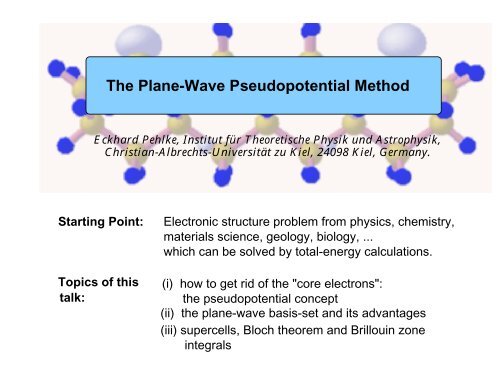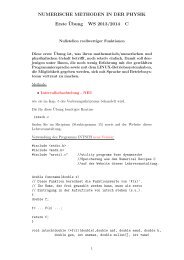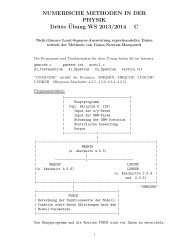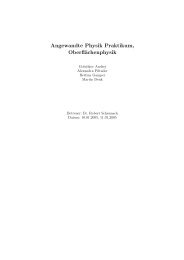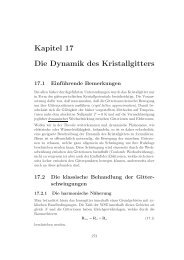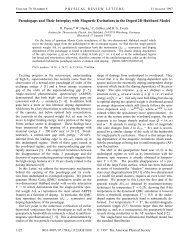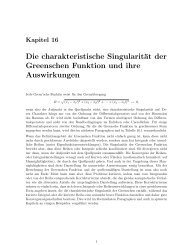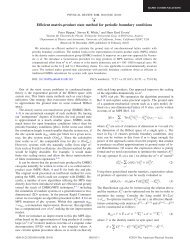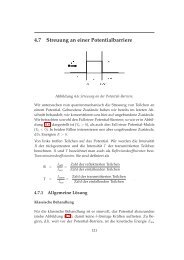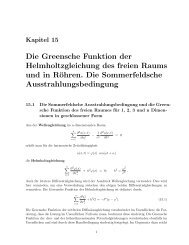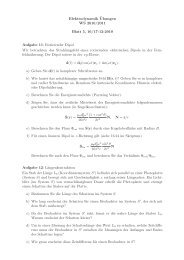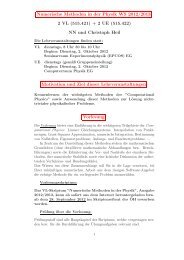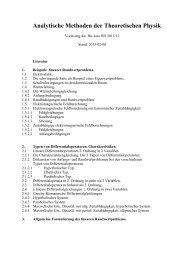The Plane-Wave Pseudopotential Method - Theory Department of ...
The Plane-Wave Pseudopotential Method - Theory Department of ...
The Plane-Wave Pseudopotential Method - Theory Department of ...
Create successful ePaper yourself
Turn your PDF publications into a flip-book with our unique Google optimized e-Paper software.
<strong>The</strong> <strong>Plane</strong>-<strong>Wave</strong> <strong>Pseudopotential</strong> <strong>Method</strong><br />
Eckhard Pehlke, Institut für <strong>The</strong>oretische Physik und Astrophysik,<br />
Christian-Albrechts-Universität zu Kiel, 24098 Kiel, Germany.<br />
Starting Point: Electronic structure problem from physics, chemistry,<br />
materials science, geology, biology, ...<br />
which can be solved by total-energy calculations.<br />
Topics <strong>of</strong> this<br />
talk:<br />
(i) how to get rid <strong>of</strong> the "core electrons":<br />
the pseudopotential concept<br />
(ii) the plane-wave basis-set and its advantages<br />
(iii) supercells, Bloch theorem and Brillouin zone<br />
integrals
Treatment <strong>of</strong> electron-electron interaction<br />
Hartree-Fock (HF)<br />
Configuration-Interaction (CI)<br />
Quantum Monte-Carlo (QMC)<br />
Density-Functional <strong>The</strong>ory (DFT)<br />
ÚÒ℄ Ì Ò℄<br />
Ò Ö Ò Ö<br />
Ö Ö <br />
ÑÒ<br />
Ê Ò Ö ÖÆ<br />
Ò Ö<br />
Ú Ö Ò Ö Ö<br />
Ö Ö Ò℄<br />
Ö Ú Ö<br />
Ö Ö Ö Ú Ö Ö Ö<br />
<br />
Ò Ö Ö Ú Ö ÆÒ℄<br />
<br />
ÚÒ℄<br />
ÆÒ Ö<br />
Problem: Approximation to XC functional.
single molecule or<br />
cluster<br />
periodically repeated<br />
supercell, slab-geometry<br />
true half-space geometry,<br />
Green-function methods<br />
Simulation <strong>of</strong> Atomic Geometries<br />
Example: chemisorption site & energy <strong>of</strong> a particular atom on a surface = ?<br />
How to simulate adsorption geometry?<br />
Use Bloch theorem.<br />
Efficient Brillouin zone<br />
integration schemes.
linear combination <strong>of</strong><br />
atomic orbitals (LCAO)<br />
plane waves (PW)<br />
augmented plane waves<br />
(APW)<br />
Basis Set to Expand <strong>Wave</strong>-Functions<br />
and other basis functions<br />
Ö Ö Ô<br />
Æ<br />
<br />
Ö <br />
. . .<br />
<br />
<br />
Ê<br />
¡Ê Ù Ø<br />
Ö Ê <br />
Ö<br />
¡Ö<br />
Ô <br />
ª<br />
simple, unbiased,<br />
independent <strong>of</strong><br />
atomic positions
I. <strong>The</strong> <strong>Pseudopotential</strong> Concept
Core-States and Chemical Bonding?<br />
Validity <strong>of</strong> the Frozen-Core Approximation<br />
U. von Barth, C.D. Gelatt, Phys. Rev. B 21, 2222 (1980).<br />
bcc fcc Mo, transformation energy 0.5 eV/atom<br />
core kinetic energy change <strong>of</strong> 2.7 eV<br />
but: error <strong>of</strong> total energy due to frozen-core approximation is small,<br />
less than 2% <strong>of</strong> structural energy change<br />
reason: frozen-core error <strong>of</strong> the total energy is <strong>of</strong> second order<br />
Æ <br />
Ú £<br />
« Ú « Ö
Al<br />
Z = 13<br />
Remove Core-States from the Spectrum:<br />
Construct a Pseudo-Hamiltonian<br />
3p<br />
3s<br />
2p<br />
2s<br />
1s<br />
occupation, eigenvalue<br />
1 -2.7 eV<br />
2 -7.8 eV<br />
6 -69.8 eV<br />
2 -108 eV<br />
2 -1512 eV<br />
valence<br />
core-<br />
states<br />
Ö Ú « Ö Ú Ô×<br />
«<br />
Ô×<br />
<br />
Ô×<br />
<br />
V. Heine, "<strong>The</strong> <strong>Pseudopotential</strong> Concept", in: Solid State Physics 24, pages 1-36,<br />
Ed. Ehrenreich, Seitz, Turnbull (Academic Press, New York, 1970).<br />
2p<br />
1s<br />
1 -2.7 eV<br />
2 -7.8 eV<br />
pseudo-<br />
Al<br />
Z = 3
Orthogonalized <strong>Plane</strong> <strong>Wave</strong>s (OPW)<br />
How to construct<br />
(ps)<br />
v<br />
in principle ?<br />
(actual proc. -> Martin Fuchs)<br />
Definition <strong>of</strong> OPWs:<br />
Expansion <strong>of</strong> eigenstate in terms <strong>of</strong> OPWs:<br />
Secular equation:<br />
Re-interpretation:<br />
Pseudo-wavefunction:<br />
OPW-Pseupopotential:<br />
ÇÈ Ï ÈÏ <br />
with<br />
Al<br />
3p<br />
3s<br />
2p<br />
2s<br />
1s<br />
ÈÏ <br />
<br />
<br />
ÇÈ Ï À ÇÈ Ï <br />
Ø<br />
<br />
Ô×<br />
Ø ÈÏ À Ö Ú « Ö Ú Ô×<br />
«<br />
Ô×<br />
<br />
1 -2.7 eV<br />
2 -7.8 eV<br />
6 -69.8 eV<br />
2 -108 eV<br />
2 -1512 eV<br />
valence<br />
core-<br />
states<br />
ÇÈ Ï <br />
<br />
ÈÏ <br />
ÈÏ <br />
Ú Ô× ÇÈÏ Ú <br />
2p<br />
1s<br />
1 -2.7 eV<br />
2 -7.8 eV<br />
Ô×<br />
<br />
pseudo-<br />
Al<br />
Ô×
<strong>Pseudopotential</strong>s and Pseudo-wavefunctions<br />
<strong>Pseudopotential</strong>s are s<strong>of</strong>ter<br />
than all-electron potentials.<br />
(<strong>Pseudopotential</strong>s do not<br />
have core-eigenstates.)<br />
Cancellation <strong>The</strong>orem:<br />
If the pseudizing radius is taken<br />
as about the core radius, then<br />
v (ps) is small in the core region.<br />
Ú Ô× ÇÈÏ ¨ Ú ¨<br />
Ú¨<br />
V. Heine, Solid State Physics 24, 1 (1970).<br />
u(r)<br />
0.7<br />
0.5<br />
0.3<br />
0.1<br />
−0.1<br />
−0.3<br />
Al<br />
pseudo<br />
wavefunction<br />
1s r c =1.242<br />
3s<br />
0.15bohr<br />
all−electron wavefunction<br />
0 2 4 6<br />
r (bohr)<br />
Pseudo-wavefunction is node-less.<br />
<strong>Plane</strong>-wave basis-set feasible.<br />
Justification <strong>of</strong> NFE model.<br />
created with<br />
fhi98PP
Computation <strong>of</strong> Total-Energy Differences<br />
all-electron atom:<br />
(Z = 32)<br />
pseudo-atom:<br />
(Z’ = 4)<br />
E = -2096 H<br />
E<br />
typical structural<br />
total-energy difference:<br />
(dimer buckling,...)<br />
total<br />
Ge atom<br />
slab, ~ 50 Ge atoms<br />
~ 10 5 H<br />
2<br />
total = -3.8 H ~ 10 H<br />
few 100 meV<br />
~ 10 -2 H
II. <strong>The</strong> <strong>Plane</strong>-<strong>Wave</strong> Expansion <strong>of</strong> the<br />
Total Energy<br />
J. Ihm, A. Zunger, M.L. Cohen, J. Phys. C 12, 4409 (1979).<br />
M. Bockstedte, A. Kley, J. Neugebauer, M. Scheffler, CPC 107, 187 (1997).
<strong>Plane</strong>-<strong>Wave</strong> Expansion <strong>of</strong> Kohn-Sham-<strong>Wave</strong>functions<br />
Translationally invariant system (supercell) --> Bloch theorem (k: Blochvector)<br />
Ö Ê ¡Ê Ö<br />
<strong>Plane</strong>-wave expansion <strong>of</strong> Kohn-Sham states (G: reciprocal lattice vectors)<br />
Ö <br />
Electron density follows from sum over all occupied states:<br />
Kohn-Sham equation in reciprocal space:<br />
<br />
Ò Ö <br />
Ó<br />
<br />
<br />
<br />
<br />
ª <br />
Ö <br />
¡Ö<br />
<br />
Ô<br />
ª<br />
<br />
ª<br />
(for semiconductors)<br />
Æ Ú «
Hohenberg-Kohn Functional in Momentum Space<br />
Total-energy functional:<br />
ØÓØÐ Ê ℄ ÌË Ô×ÐÓ Ô×ÒÓÒ ÐÓ À ÁÓÒ ÁÓÒ<br />
Obtain individually convergent energy terms by adding or subtracting superposition<br />
<strong>of</strong> Gaussian charges at the atomic positions:<br />
Ò Ù×× Ö <br />
Ê<br />
Define valence charge difference wrt. above Gaussian charge density:<br />
<br />
Ö Ù××<br />
Ò Ö Ò Ö Ò Ù×× Ö<br />
Ö Ê Ö Ù××<br />
<strong>The</strong> total energy can thus be written as the sum <strong>of</strong> individually well defined energies<br />
ØÓØÐ ÌË<br />
Ô×ÐÓ Ô×ÒÓÒ ÐÓ ÀÒ℄ <br />
ÁÓÒ ÁÓÒ ×Ð
Hohenberg-Kohn Functional in Momentum Space<br />
(continued)<br />
Ó <br />
kinetic energy:<br />
local pseudopotential energy:<br />
(only one kind <strong>of</strong> atoms)<br />
Ö<br />
with <br />
structure factor<br />
¡<br />
and<br />
Ú Ö Ú Ô×ÓÒ<br />
non-local pseudopotential energy<br />
Hartree energy:<br />
exchange-correlation<br />
energy:<br />
Ion-Ion Coulomb interaction:<br />
Gaussian self energy:<br />
Ì Ë <br />
<br />
ª <br />
<br />
ª<br />
Ô×ÐÓ<br />
<br />
<br />
ª <br />
<br />
Ë Ú Ò<br />
Ù××Ø<br />
Ò Ö<br />
<br />
Ö Ö Ö Ë <br />
ÀÒ℄ ª <br />
<br />
<br />
Ò <br />
Ä<br />
Ò Ò ÓÖ ℄ <br />
×Ð <br />
<br />
ª<br />
ÁÓÒ ÁÓÒ <br />
<br />
Ô <br />
Ê Ê<br />
<br />
Ö Ò Ö Ò ÓÖ Ö ¯ ÓÑ<br />
Ò Ö Ò ÓÖ Ö<br />
<br />
ÖÙ××<br />
<br />
Ê<br />
Ö Ê<br />
Õ ÖÙ×× Ö Ù××
Kinetic Energy Cut-Off and Basis-Set Convergence<br />
Size <strong>of</strong> plane-wave basis-set limited<br />
by the kinetic-energy cut-<strong>of</strong>f energy:<br />
(Note: Conventionally, cut-<strong>of</strong>f energy<br />
is given in Ry, then factor "2" is<br />
obsolete.)<br />
Efficient calculation <strong>of</strong> convolutions:<br />
<br />
Ö Ò<br />
Ô ÙØ<br />
Ú ÐÓ <br />
FFT FFT<br />
-1<br />
mult.<br />
Ú ÐÓ Ö Ò Ö Ò<br />
Real space mesh fixed by sampling<br />
theorem.<br />
Basis-set convergence <strong>of</strong> total energy:<br />
−2.047<br />
−2.057<br />
−2.067<br />
kin<br />
E 5 Ry<br />
cut<br />
7 Ry<br />
9 Ry<br />
11 Ry<br />
13 Ry<br />
15 Ry<br />
Al<br />
−2.077<br />
7.0 7.2 7.4 7.6 7.8 8.0<br />
lattice constant [bohr]
Advantages <strong>of</strong> <strong>Plane</strong>-<strong>Wave</strong> Basis-Set<br />
(1) basis set is independent <strong>of</strong> atom positions and species, unbiased<br />
(2) forces acting on atoms are equal to Hellmann-Feynman forces,<br />
no basis-set corrections to the forces (no Pulay forces)<br />
(3) efficient calculation <strong>of</strong> convolutions,<br />
use FFT to switch between real space mesh and reciprocal space<br />
(4) systematic improvement (decrease) <strong>of</strong> total energy with increasing<br />
size <strong>of</strong> the basis set (increasing cut-<strong>of</strong>f energy):<br />
can control basis-set convergence<br />
Remark: When the volume <strong>of</strong> the supercell is varied, the number <strong>of</strong> planewave<br />
component varies discontinuously. Basis-set corrections are available<br />
(G.P. Francis, M.C. Payne, J. Phys. Cond. Matt. 2, 4395 (1990).)
III. Brillouin Zone Integration and<br />
Special k-Point Sets<br />
(i) General Considerations<br />
(ii) Semiconductors & Insulators<br />
(iii) Metals<br />
D.J. Chadi, M.L.Cohen, Phys. Rev. B 8, 5747 (1973).<br />
H.J. Monkhorst, J.D. Pack, Phys. Rev. B 13, 5188 (1976).<br />
R.A. Evarestov, V.P. Smirnov, phys. stat. sol. (b) 119, 9 (1983).
Make use <strong>of</strong> supercells and exploit translational invariance; apply Bloch theorem.<br />
Ò Ö <br />
<strong>The</strong> Brillouin Zone Integration<br />
Charge density and other quantities are represented by Brillouin-zone integrals:<br />
Ò Ö <br />
Ó <br />
<br />
Ó<br />
<br />
ª <br />
ÆÔØ Ò<br />
Ö <br />
<br />
ª<br />
ÛÒ Ò Ö <br />
(for semiconductors / insulators)<br />
Smooth integrand => approximate integral by a weighted sum over special points:<br />
This is the "trick" by which we get rid <strong>of</strong> the many degrees <strong>of</strong> freedom from the<br />
crystal electrons!
Special Points for Efficient Brillouin-Zone Integration<br />
Calculate integrals <strong>of</strong> the type<br />
Æ<br />
<br />
<br />
<br />
ª <br />
<br />
<br />
ª<br />
<br />
f(k) periodic in reciprocal space, ,<br />
<br />
<br />
Ñ<br />
Ñ Ñ <br />
with Ñ <br />
and<br />
<br />
« <br />
¡ «ÊÑ <br />
Û Ñ ÆÑ ÓÖ Ñ Å<br />
Æ<br />
<br />
Û ÑÅ<br />
Ñ<br />
Æ<br />
<br />
with<br />
f(k) symmetric with respect to all point group symmetries.<br />
Expand f(k) into a FOURIER series:<br />
Choose special points k<br />
i<br />
(i=1, ..., N) and weights w such that<br />
i<br />
Û Ñ <br />
<br />
for M as large as possible. <strong>The</strong> real-space vectors R<br />
m<br />
are assumed to be ordered<br />
according to their length.<br />
<strong>The</strong>n:<br />
error <strong>of</strong> BZ integration scheme
( )<br />
Special k-Points for 2D Square Lattice<br />
Let point group be C (not C4v<br />
).<br />
4<br />
k i<br />
7 1<br />
( ) 20 20<br />
__ __<br />
( 20 20)<br />
__ __<br />
( 20 20)<br />
9 7<br />
__ __<br />
( 20 20)<br />
__ __<br />
( 20 20)<br />
__ __<br />
_1<br />
( )<br />
1 3 3 9 5 5<br />
_1 _1 _1 _1 _1<br />
( ) ( )<br />
6 6 3 3 6 2 0<br />
0<br />
_1<br />
( ) _1<br />
( ) _<br />
( ) _<br />
_1 _1<br />
4 4<br />
_1 _1 ( 0<br />
_1 ) ( )<br />
4 2 4<br />
_1<br />
_2<br />
( 0 0)<br />
( ) 5 5<br />
_1 3_ 3 _1 3 3_<br />
8 8 8 8 8 8 8 8<br />
( )<br />
( )<br />
_1 _1<br />
( ) 2 3<br />
Lattice vector a<br />
1<br />
= aex , a<br />
2<br />
= aey _1 _1<br />
2 2<br />
_ _<br />
1 4<br />
5 5<br />
_1<br />
4<br />
_1<br />
4<br />
_1<br />
4<br />
_1<br />
4<br />
_2 2_ 2_ _1 2_<br />
9 9 9 9 9<br />
_1<br />
5<br />
w i<br />
1 1<br />
R.A. Evarestov, V.P. Smirnov, phys. stat. sol. (b) 119, 9 (1983).<br />
_1<br />
5<br />
_1<br />
5<br />
_1<br />
5<br />
_1<br />
5<br />
N M<br />
2<br />
2<br />
4<br />
3<br />
6<br />
4<br />
5 15<br />
5<br />
12<br />
16
Equally spaced k-point mesh in reciprocal space:<br />
Ù £ Ù £ Ù £ Ð Ð Ð<br />
and<br />
Monkhorst-Pack Special k-Points<br />
Ù <br />
Û <br />
Ð<br />
Ð<br />
Restrict k-point set to points in the irreducible part <strong>of</strong> the Brillouin zone.<br />
Weight <strong>of</strong> each point ~ number <strong>of</strong> points in the star <strong>of</strong> the respective wave vector:<br />
Weights:<br />
×ØÖ <br />
Ð Ð Ð<br />
H.J. Monkhorst, J.D. Pack, Phys. Rev. B 13, 5188 (1976).<br />
.
k y<br />
1.6<br />
0.6<br />
−0.4<br />
Special k-Points for 2D Hexagonal Lattice<br />
−1.4<br />
−1.6 −0.6 0.4 1.4<br />
kx b<br />
attention: even q (q=4)<br />
incomplete k-point mesh<br />
2<br />
b<br />
1<br />
k y<br />
1.6<br />
0.6<br />
−0.4<br />
b 2<br />
−1.4<br />
−1.6 −0.6 0.4 1.4<br />
kx q=5 (MP)<br />
J.D. Pack, H.J. Monkhorst,<br />
PRB 16, 1748 (1977).<br />
b<br />
1
Why Few k-Points Already Work Fine for Semiconductors<br />
Semiconductors and insulators: always integrate over complete bands!<br />
Ò Ö <br />
Ó <br />
<br />
ª <br />
Ö <br />
Introduce Wannier-functions for the j-th band:<br />
True charge density from the j-th band:<br />
Ò Ö <br />
Æ Û<br />
<br />
Ò Ö Ò Ö ÆÊ<br />
<br />
Ê<br />
<br />
« <br />
« Ö ÆÊ<br />
<br />
Ê Ê Ê Å<br />
Æ<br />
<br />
<br />
ª<br />
Ò Ö ÆÊ<br />
Û Ê Ê <br />
Ö Ô ÆÊ<br />
Approximate charge density (from sum over special k-points):<br />
<br />
R.A. Evarestov, V.P. Smirnov, phys. stat. sol. (b) 119, 9 (1983).<br />
Ê<br />
Ê<br />
Æ<br />
<br />
Ê<br />
<br />
<br />
Ê<br />
Û Ö Ê <br />
Û £<br />
Ö Ê Û Ö Ê<br />
¡Ê Û Ö Ê<br />
Û Ê Ê Û £<br />
Ö Ê Û Ö Ê<br />
Error <strong>of</strong> integration scheme = overlap <strong>of</strong> Wannier functions with distance > C .<br />
Even faster convergence (due to the more localized atomic orbitals) for total<br />
charge density.<br />
M
"Smearing" <strong>of</strong> Fermi surface in order to improve<br />
convergence with number <strong>of</strong> k-points, e.g. by<br />
choosing an artificially high electron temperature<br />
(0.1 eV).<br />
Ì Ì <br />
Ì Ì <br />
... And Why Metals Need Much More k-Points<br />
Metals: partially filled bands; k-points have to sample the shape <strong>of</strong> the Fermi surface.<br />
Ò Ö <br />
<br />
<br />
ª <br />
<br />
<br />
Ì<br />
Extrapolate to zero temperature by averaging the<br />
free energy A and the inner energy E:<br />
Ì Ì <br />
Respective corrections to the forces.<br />
Ö <br />
lattice constant c [bohr]<br />
7.637 7.642 7.647 7.652 7.657<br />
F. Wagner, Th. Laloyaux, M. Scheffler, Phys. Rev. B 57, 2102 (1998).<br />
For some quantities and materials "smearing" can lead to<br />
serious problems. M.J. Mehl, Phys. Rev. B 61, 1654 (2000).<br />
<br />
ª<br />
kT el = 0.25 eV<br />
kT el = 0.5 eV<br />
kT el = 0.1 eV<br />
Al<br />
0 100 200 300<br />
# k−points in IBZ<br />
M. Lindenblatt, E.P.
Summary: <strong>The</strong> <strong>Plane</strong>-<strong>Wave</strong> <strong>Pseudopotential</strong> <strong>Method</strong><br />
(1) Born-Oppenheimer approximation<br />
(2) apply density-functional theory (DFT) to calculate the electronic structure;<br />
approximation for the exchange-correlation energy-functional (LDA, GGA, ...)<br />
approximate treatment <strong>of</strong> spin effects (LSDA, ...)<br />
(3) construct pseudopotentials: get rid <strong>of</strong> core electrons<br />
frozen-core approximation<br />
non-linear core-valence exchange-correlation<br />
transferability <strong>of</strong> the pseudopotential<br />
(4) specify atomic geometry, e.g. slab and periodically repeated supercells<br />
convergence with cell size (cluster size)<br />
(5) plane-wave basis-set: unbiased, no basis-set corrections to the forces,<br />
switch between real space and reciprocal space via FFT<br />
convergence <strong>of</strong> total-energy differences with kinetic-energy cut-<strong>of</strong>f<br />
(6) Brillouin-zone integrals approximated by sums over special k-points<br />
check the convergence with number <strong>of</strong> k-points and Fermi-surface smearing<br />
(different for semiconductors/insulators and metals!)


